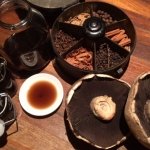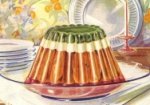In this, the KFC and BBQ’d chicken age, where even good quality cooked chooks can cost less than a fresh chicken to prepare at home, it seems extraordinary that on the most elegant tables in the eighteenth and nineteenth centuries, there was an open preference for boiled fowl. And for those of us who savour the richly browned skin of a roasted (oops – baked – we’ve already had that debate here with the Curator), chicken, and rich moist stuffing within, even though we know they’re the naughtiest parts of the ‘roast’, the idea of a pale and damp looking ‘boiler’ leaves much to be desired.
White out
The temptation is tempered even further by the specimen in question being adorned with a white bechamel or masking sauce, the standard accompaniment to boiled fowl. To jazz things up a bit, Eliza Acton (1845) recommends other sauces, albeit very pale, such as celery sauce, creamy oyster sauce or white-mushroom sauce (made with button mushrooms); Mrs Beeton a nice sounding lemon sauce (recipe below). To ornament your chickens for the table Eliza suggests, ‘small tufts of delicately boiled cauliflower placed round them; or young vegetable marrow scarcely larger than an egg, merely pared and halved after it is dressed: white sauce must be served with both these’ (- enter the cauliflower cheese, or au gratin – which I do love to serve with roast chicken).
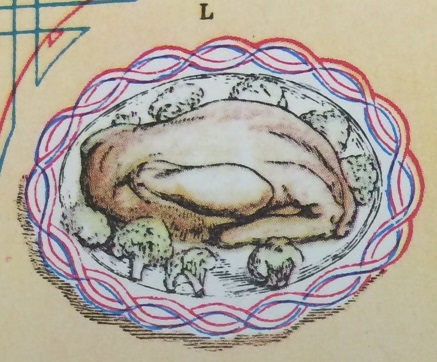
Boiled fowl with cauliflower illustrated in Mrs Isabella Beeton, Book of household management, Johnathan Cape, London, 1861, reproduced in facsimile 1968
Ebony and ivory
Clearly the culinary ‘sin’ of an all white dish had not yet taken hold. In some cultures white foods represent death, so rarely acceptable except at funerals or wakes; in others it signifies purity. The recommendation that ‘white legged poultry should always be selected for boiling’ reminds us that chickens were not the uniform ‘white meat’ bird we are used to now – ‘fowl’ generally meant ‘poultry’ so guinea fowl, pigeons, larks, ducks, turkeys all entered the mix. And not all chickens were pale coloured: black skinned Silkie chickens, of east Asian origin, are known to make the best chicken soup and have health-giving qualities in Chinese medicine. You might enjoy this New York Times article on this culinary curiosity here.
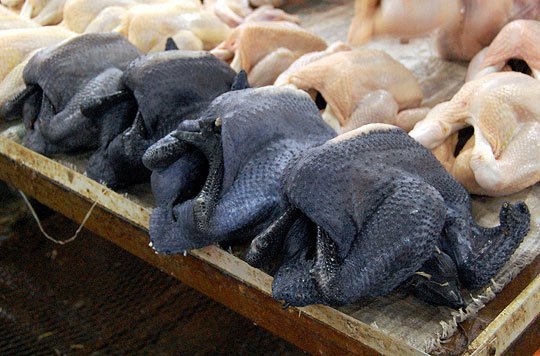
Dark Silkie chickens. www.thekitchn.com/whats-the-deal-with-black-chic-80171
Oddly enough, Silkies have very whispy white feathers, so are best known in the chicken ‘run’ for their ornamental qualities (following Scott’s Chicken or egg? post last week). According to Wright’s Illustrated book of poultry (1873)
‘”On table it is a revolting-looking dish. But taste it!” … The skin is of a deep violet colour, almost black, and the surface of the bones is the same, making the bird a queer looking dish to partake of though excellent eating to those who can carry the maxim ‘handsome is that handsome does’…
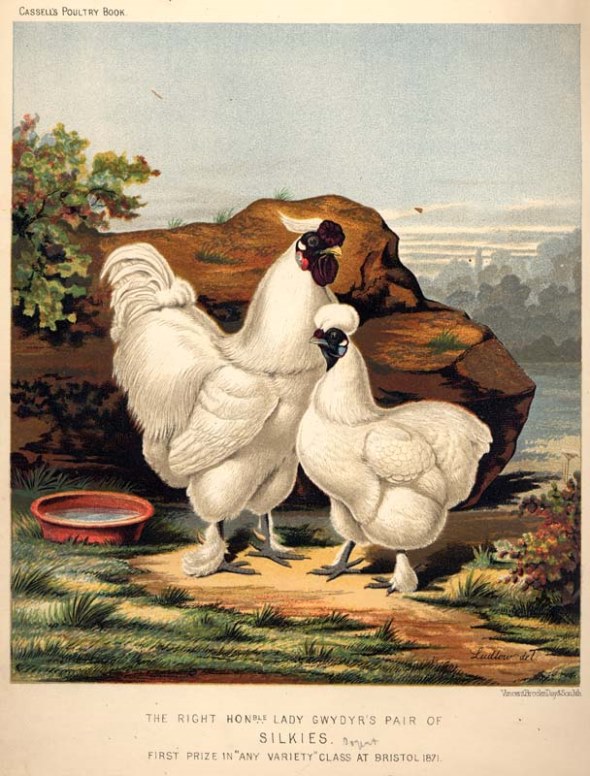
Silkie chickens from Lewis Wright, The Illustrated Book of Poultry, Cassell and Company Ltd, London, c1875. Sydney Living Museums R86/751
Lost in translation
But in defense of ‘boiled’ fowl, or any ‘boiled’ meat, we can’t afford to judge historical dishes purely on face value. Closer reading of cookery texts reveal much more nuanced practices than the often unbecoming titles suggest, and we come to appreciate that ‘boiling’ doesn’t necessarily mean cooking at 100 degrees (or 212° Fahrenheit). Eliza Acton instructs, ‘let them be well covered with water, which should be hot but not boiling when they are put in. A full sized fowl will require about three-quarters of an hour from the time of its beginning to simmer’ – do we assume we leave it at a simmer, or let it cook at a rapid boil? Logic (and experience, sadly) tells us that the bird would become tough, dry and hard if left to boil for any length of time. Eliza continues ‘but young chickens not more than from twenty to twenty-five minutes should be very gently boiled…’. Modern culinary language is far more prescriptive and discriminating, identifying increments in, shall we say, cooking in fluids – from a rolling or hard boil, ‘just boiling’ ie kept just at boiling point, a steady simmer, a gentle simmer, to poach, to steep.
Not so foreign after all
Maria Rundell’s A new system of domestic cookery (1816) offers another ‘white on white’ combination, with the addition of rice – the ultimate comfort food I would say, and reminiscent of another ‘white’ chicken and rice dish some of you might be familiar with …
To boil fowl with Rice.
Stew the fowl very slowly in some clear mutton-broth well skimmed; and season with onion, mace, [white] pepper, and salt. About half an hour before it is ready, put in a quarter of a pint of rice well washed and soaked. Simmer till tender; then strain it from the broth, and put the rice on a sieve before the fire. Keep the fowl hot, lay it in the middle of the dish, and the rice around it without the broth. The broth will be very nice to eat as such, but the less liquor the fowl is done with the better.
Sounds familiar? The delicate but delicious Hainan or ‘white cut’ chicken, from Chinese hakka cuisine comes immediately to mind, a whole bird carefully steeped in a fragrant white stock, served with steamed white rice cooked in some of the stock and a salty garlic and shallot infused hot oil as a dipping sauce. Remaining broth is taken as soup as a side dish (the way miso soup is taken with a Japanese meal).
Plain language, plain food?
Australian food writer Charmaine O’Brien (one of our fabulous recipe testing volunteers) was recently commended by the Sophie Coe Prize panel from Oxford University for her article Text for Dinner: ‘Plain’ Food in Colonial Australia … Or, Was It? on reading between the lines when interpreting old recipes.
Her closing paragraph demonstrates how we are often quick to judge old recipes as unappealing or simply, bad food, because of their title: Charmaine ‘took a recipe from Cookery Recipes For The People [by Margaret Pearson, 1888] and reframed its title and description in a modern food writing style’ partly as a comment on the modern penchant for excessively descriptive way of enticing diners to a dish:
The recipe in question is titled “White Sauce” and Pearson writes that “this sauce will answer well for boiled fowl”: hardly language to make the dish sound appealing to the modern cook, and likely to confirm an expectation of plain cookery as tasteless and boring. But what if the recipe remained the same but the words used to describe it were changed, for example: the title to “Salsa Blanca” and the introductory remark to “this luxurious silky sauce infused with eschalot, mace, lemon, and sherry wine is perfect for perking up poached free-range chicken”. How much better might it then taste?’ Charmaine O’Brien. 2013.
Lemon sauce for boiled fowl
Ingredients
- 1 lemon, with thin skin, if possible
- 400ml milk
- 100g softened butter
- 2 heaped teaspoons flour
- ground white pepper
- pinch ground nutmeg
Note
This recipe is inspired by Mrs Isabella Beeton's 'Lemon sauce for boiled fowl', which published as two 'receipts': one for the foundation 'melted butter' sauce of flour, butter and milk, and the other adding the lemon. Upon testing Mrs Beeton's version I wondered if perhaps there was a step or a cooking time reference missing, as the lemon peel had little time to cook and was hard. This seemed to upset the delicate texture of the poached chicken, so I've modified the instructions accordingly, and brought them into one single recipe.
Unlike a French roux-style white sauce, this one is buttery-rich – in contrast to the simplicity and uncomplicated nature of 'boiled' fowl.
Directions
| Cook | |
| Peel the skin from the lemon in long strips. Remove the pith with a paring knife and discard. Set the skin aside. Slice the skinned fruit thinly, remove and discard any excess pith and seeds, then chop the flesh finely and set aside. Warm the milk and lemon peel in a saucepan over low heat, simmering very gently for 10–15 minutes. Remove from the heat and allow to steep for 30 minutes. Meanwhile, mix the butter and flour smoothly together on a small plate. Put the butter mixture into a small saucepan, then strain the lemon-infused milk into the pan, adding three pinches of salt, the pepper and the nutmeg, if using. Place over medium heat and stir constantly in one direction (eg, clockwise) with a wire whisk until the butter is incorporated and the sauce is smooth. Lower the heat and simmer for 2 minutes, then check the seasoning. Add the chopped lemon and simmer for just a few minutes. Pour over the boiled chicken or serve separately in a sauce boat. | |
For the purists: Mrs Beeton’s original recipes. Note that the foundation ‘melted butter’ sauce no. 380. makes about half a pint, not 3/4s. The modern recipe above makes that adjustment.
MELTED BUTTER MADE WITH MILK.
380. INGREDIENTS.—1 teaspoonful of flour, 2 oz. butter, 1/3 pint of milk, a few
grains of salt.
Mode.—Mix the butter and flour smoothly together on a plate, put it into a lined
saucepan, and pour in the milk. Keep stirring it one way over a sharp fire; let it boil
quickly for a minute or two, and it is ready to serve. This is a very good foundation
for onion, lobster, or oyster sauce: using milk instead of water makes it look so much
whiter and more delicate.
Time.—Altogether, 10 minutes. Average cost for this quantity, 3d.LEMON SAUCE FOR BOILED FOWLS.
457. INGREDIENTS.—1 small lemon, 3/4 pint of melted butter, No. 380.
Mode.—Cut the lemon into very thin slices, and these again into very small dice.
Have ready 3/4 pint of melted butter, made by recipe No. 380; put in the lemon; let it
just simmer, but not boil, and pour it over the fowls.
Sources
See ‘our bookshelf’ for publisher destails
Eliza Acton, Modern cookery for private families (1845); Maria Rundell, A new system of domestic cookery (1816); Isabella Beeton, Book of household management (1861).
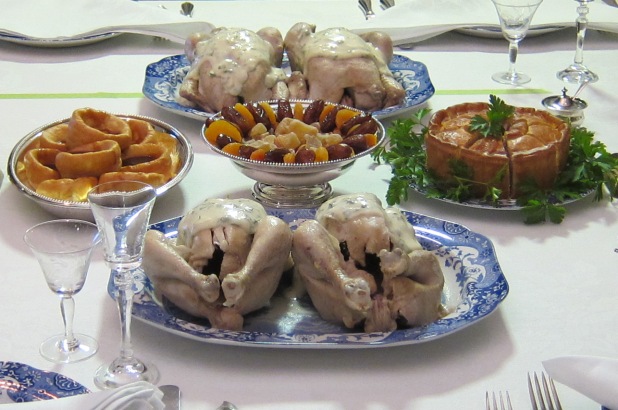
 Print recipe
Print recipe
